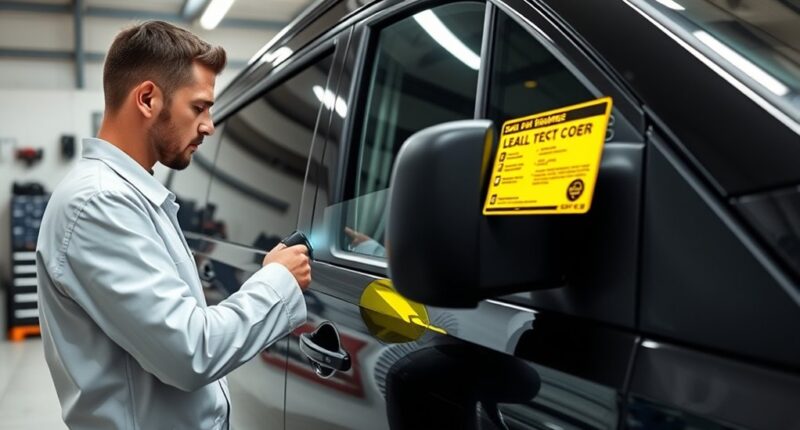To comply with vehicle safety standards, you need to identify which regulations apply based on your vehicle’s classification and weight, then guarantee your design meets all crashworthiness, lighting, and equipment requirements. Conduct proper testing, certification, and keep detailed records of inspections and compliance. Stay informed about updates from authorities like FMVSS, and work with industry experts and regulators to maintain standards. Continuing to explore these topics will help you implement all necessary safety measures effectively.
Key Takeaways
- Identify applicable safety standards based on vehicle classification, weight, and type, such as FMVSS or FMVSS 105.
- Ensure vehicle design meets crashworthiness, impact protection, and safety feature requirements, including airbags and electronic stability controls.
- Conduct proper testing and certification following protocols like California’s BAR-SIS, maintaining detailed records of compliance.
- Stay informed on regulatory updates, upcoming standards, and industry guidelines through official publications and industry seminars.
- Collaborate with regulatory agencies and industry partners to implement safety innovations and ensure ongoing compliance.
Understand the Scope of FMVSS Regulations
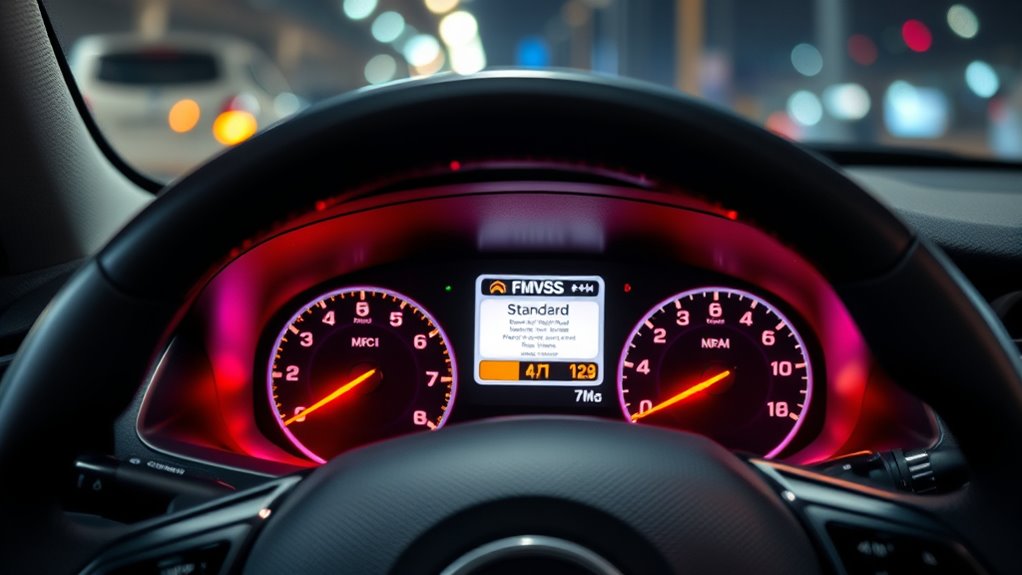
Have you ever wondered what sets the safety standards for vehicles in the U.S.? The FMVSS regulations define the scope of safety requirements your vehicle must meet. These standards cover critical areas like crashworthiness, braking systems, lighting, and visibility. They also include tire and wheel integrity as well as steering system performance, ensuring your vehicle can handle real-world conditions safely. Additionally, regulations address vehicle modifications to prevent unsafe alterations that could compromise safety. The regulations establish minimum performance criteria to prevent unreasonable risks caused by design or construction flaws. They are continually refined through reviews of safety data to incorporate emerging safety challenges and technological advances. By understanding this scope, you can better grasp what manufacturers are required to implement for your vehicle’s safety and compliance.
Identify Applicable Standards for Your Vehicle Type

To determine which safety standards apply to your vehicle, you need to take into account its classification and weight. NHTSA categorizes vehicles by class and curb weight, which influence the standards you must meet. For example, vehicles over 7,716 lbs GVWR must comply with FMVSS 105, while those between 1,500 and 1,999 lbs fall into different categories with specific requirements. Class types like SUVs, pickup trucks, and vans each have unique standards. Heavy-duty vehicles exceeding 10,000 lbs GVWR follow separate regulations, such as FMVSS 119 for tires. Understanding your vehicle’s classification and weight helps you identify the relevant crash avoidance, crashworthiness, and post-crash standards you need to meet for compliance. Additionally, robot vacuum features such as smart sensors can influence safety considerations in certain vehicle environments. Recognizing the variety of vehicle types ensures comprehensive adherence to applicable safety standards. Being aware of lifecycle considerations can also help in maintaining compliance throughout your vehicle’s lifespan.
Ensure Vehicle Design Meets Safety Requirements
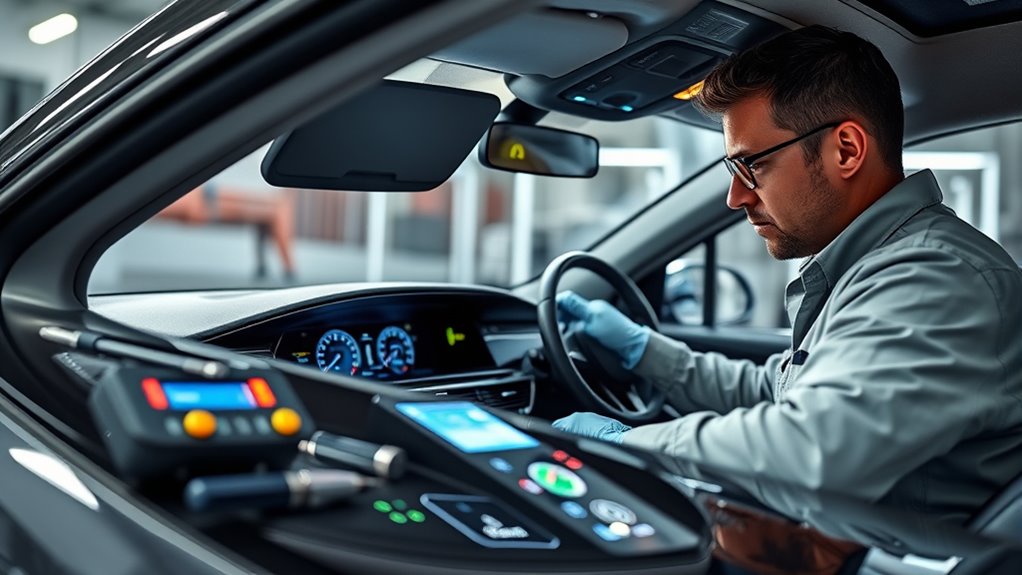
Ensuring your vehicle design meets safety requirements involves integrating multiple standards that protect occupants and enhance overall crash performance. You need to focus on crashworthiness standards, including interior impact protection, head restraints, and door locks, to minimize injury risks. Impact protection standards for steering, side, and rear impacts ensure the vehicle can withstand collisions. Incorporate proper glazing materials for windshields to prevent shattering hazards. Design seating systems that remain secure during crashes, and include effective airbag systems to cushion occupants. Material selection also plays a vital role; choose durable, fire-resistant, and corrosion-protected materials that meet safety standards. Additionally, integrating safety features like electronic stability controls, sensors, warning systems, ABS, and TPMS enhances overall safety and compliance. Paying attention to vehicle safety standards during the design phase helps ensure compliance and occupant protection. Incorporating vehicle safety regulations early in the development process can significantly improve the overall safety performance of the vehicle. Furthermore, conducting thorough safety testing throughout the development cycle is essential to validate that all safety features function correctly under various conditions.
Implement Proper Testing and Certification Procedures
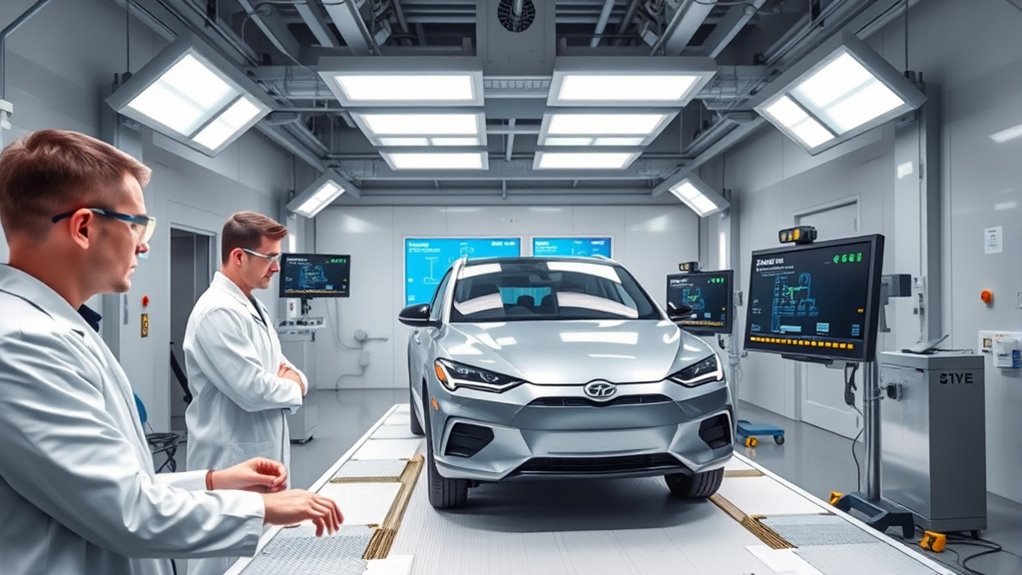
Implementing proper testing and certification procedures is essential to confirming that your vehicle meets all safety standards before hitting the road. Begin by following California’s BAR-SIS protocols, using its electronic system for data entry and certificate issuance. Conduct thorough inspections with detailed checklists, verifying equipment, signage, licenses, and reference materials. Train your technicians to review online tutorials and stay current with safety regulations, ensuring they perform inspections on critical components like brakes, lights, steering, tires, and exhaust systems. Incorporate automated testing procedures to enhance accuracy and efficiency during inspections. Incorporate training programs to keep your team informed about the latest safety standards and testing methods. Adhere to California’s audit rules by testing the first five vehicles per model year or engine family for quality assurance. Implement federal FTP testing for emissions and performance, and follow ARB protocols for modified vehicles. Schedule periodic retesting to maintain certification validity, aligning with federal standards for safety and emissions. Incorporate self-watering plant pots as an example of innovative products that promote sustainability and efficiency. Ensuring compliance with safety standards is crucial to avoiding penalties and ensuring vehicle reliability. Additionally, staying informed about the causes of narcissism can help in understanding behavioral patterns that may impact team dynamics during certification processes.
Maintain Documentation and Record-Keeping Practices

Maintaining thorough documentation and accurate record-keeping is essential for demonstrating compliance with federal and state vehicle safety standards. Proper records show your vehicle’s design, testing, and safety certifications, making audits smoother and ensuring accountability. To stay compliant, you need to:
- Keep detailed reports on vehicle manufacturing, testing protocols, and results.
- Designate a responsible person or entity to handle safety reports and inquiries.
- Retain records such as risk assessments, emergency plans, and quality control inspections for required periods.
- Ensuring records are up-to-date and complete helps facilitate easier audits and compliance verification. Regularly reviewing and updating these records ensures ongoing adherence to evolving safety standards and regulatory requirements. Additionally, maintaining organized documentation supports fire safety compliance by providing clear evidence of safety measures implemented during vehicle production. Implementing a systematic record-keeping process ensures that all relevant data are consistently captured and protected against loss or damage. Incorporating digital record management can further enhance accessibility and security of these important documents. These practices help you prove your adherence to FMVSS standards, including specific documentation for electric vehicles and safety certifications. Consistent and organized record-keeping not only supports regulatory compliance but also prepares you for audits, recalls, or safety investigations.
Stay Updated on Regulatory Changes and Updates
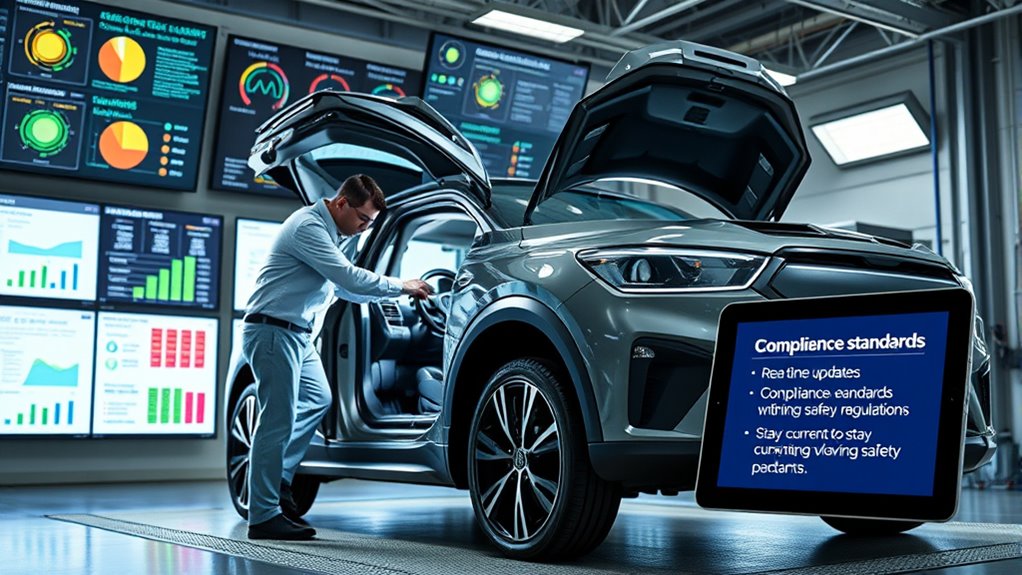
Staying updated on regulatory changes and updates is essential for keeping your vehicle safety practices compliant with evolving standards. The CVSA’s 2025 North American Standard Out-of-Service Criteria, effective April 1, 2025, sets new inspection standards. Updates to FMVSS No. 225 for child restraint systems, made in March 2025, impact safety requirements. NHTSA emphasizes timely reporting of recalls and is expected to revise policies on automated technologies and cybersecurity. California’s VSSI program now mandates ADAS inspections, like automatic braking systems. Industry publications such as the Federal Register and the National Law Review provide critical insights into regulatory developments. Staying informed helps you anticipate upcoming changes, adapt procedures, and guarantee your compliance efforts align with current standards and technological advancements. Additionally, understanding water safety standards related to vehicle operations can help prevent accidents involving water crossings or flood-prone areas. Awareness of vehicle safety equipment updates also plays a vital role in maintaining compliance and ensuring passenger safety. Regularly reviewing industry guidelines ensures your practices remain aligned with the latest safety innovations and regulations. Incorporating training programs that focus on new safety standards can further enhance your compliance efforts and safety culture. Furthermore, participating in industry seminars allows you to gain firsthand knowledge from experts about emerging safety trends and regulatory updates.
Collaborate With Regulatory Bodies and Industry Experts

Collaborating with regulatory bodies and industry experts enhances your vehicle safety efforts by fostering shared knowledge and streamlined compliance. By engaging in initiatives like the U.S.-Canada RCC Motor Vehicles Working Group, you can align safety standards and leverage cross-border testing frameworks. Forming public-private partnerships with NHTSA, Transport Canada, and research institutions accelerates safety innovations and data sharing. Utilizing regulatory tools such as pre-compliance consultations and parallel testing helps you adapt standards efficiently. Building expert advisory networks with former officials, technical committees, and legal specialists ensures informed strategies. Implementing collaborative frameworks like joint working groups and mutual recognition agreements promotes consistency. Understanding appliance testing and compatibility is also essential to ensure safety standards are maintained across different regions and appliance types.
Frequently Asked Questions
How Often Do FMVSS Standards Change or Get Updated?
You’re wondering how often FMVSS standards change or get updated. These updates happen irregularly, driven by safety needs and tech advances. Proposed changes are published in the Federal Register, with public comments before finalization. Major updates can take years to implement, and recent examples include standards for electric vehicles and automatic emergency braking. Staying informed through NHTSA’s website, Federal Register, and industry alerts helps you keep up with these evolving standards.
Are There Specific Exemptions for Certain Vehicle Types or Modifications?
You’ll find that there are specific exemptions available for certain vehicle types or modifications. For example, agricultural vehicles and low-volume or prototype vehicles can qualify for exemptions that allow operational flexibility without compromising safety. These exemptions support innovation, testing, or specialized use cases. To qualify, you need to provide detailed documentation proving that your vehicle or modification meets safety standards or offers safety improvements, along with a clear explanation of your exemption request.
What Are the Penalties for Non-Compliance With FMVSS?
If you ignore FMVSS rules, you risk facing penalties so massive they could cripple your business—up to $75,541 per violation, with potential for severe consequences like license suspension or damage to your reputation. NHTSA enforces these fines based on how many vehicles are affected and the safety risks involved. Small businesses might get some leniency, but willful violations attract the harshest penalties, so compliance is your best defense.
How Can Small Manufacturers Ensure Ongoing Regulatory Compliance?
You can guarantee ongoing compliance by staying updated on FMVSS standards, regularly reviewing regulations, and attending training sessions. Keep detailed records of your manufacturing processes and safety tests, and promptly notify NHTSA of any safety issues or noncompliance. Collaborate with industry groups for support, conduct internal audits, and maintain proper documentation. Consulting legal experts also helps you navigate regulations, ensuring your small manufacturing operation remains compliant and avoids penalties.
What Resources Are Available for Troubleshooting Compliance Issues?
When troubleshooting compliance issues, you can access various resources to help you. Visit the NHTSA website to review recall data and safety standards, and use the Vehicle Safety Hotline for direct support. The SaferCar app allows you to track safety updates for your vehicles, while regulatory documents like Letters of Interpretation clarify standards. Additionally, industry safety training and FAQs provide guidance to resolve specific compliance concerns effectively.
Conclusion
Think of complying with vehicle safety standards as guiding your ship through busy waters. By knowing the rules of the sea, checking your vessel’s design, testing thoroughly, and keeping detailed logs, you guarantee smooth sailing. Staying alert to changing weather—that is, regulations—helps you steer clear of storms. With collaboration as your trusted crew, you’ll navigate confidently toward safe, compliant journeys, turning your vehicle into a sturdy vessel built for safe passage on every road.
